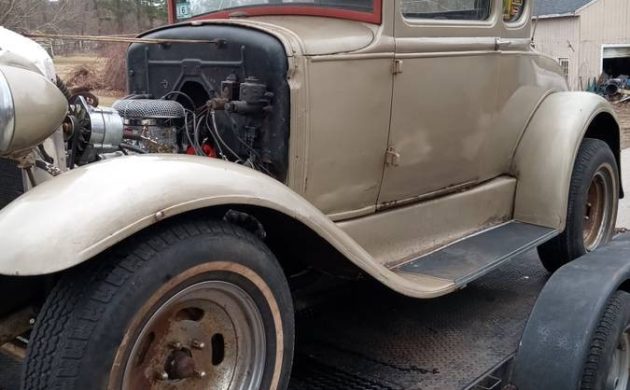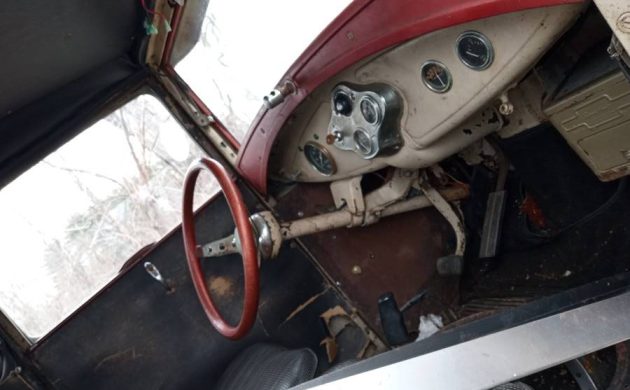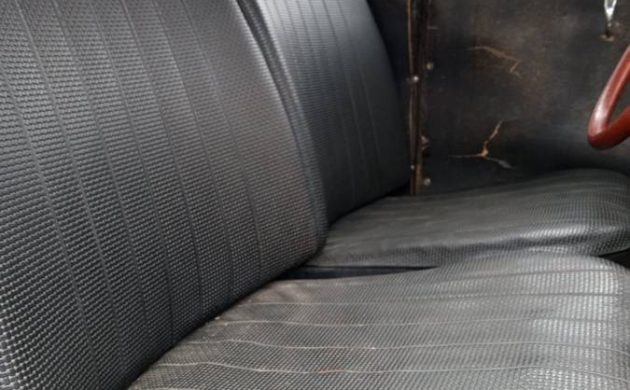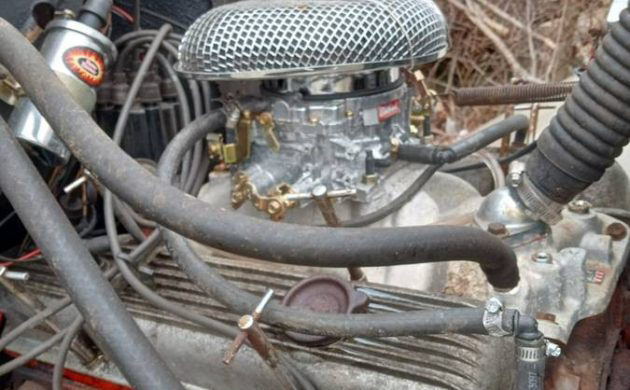
Every once in a while, an archaeological find of recent vintage hits the internet. Be it an old dealership that closed its doors and never opened back up again, or that suburban garage that finally opened up to reveal a perfectly preserved old car, there are wonders from the past out there if you just look. Take for example this 1931 Ford Model A coupe for sale on Craigslist in Hampstead, New Hampshire. Claimed to be a hot rod built in the swinging sixties, this gold coupe has fallen upon hard times. It does, however, reveal a lot of clues as to how hot rods were built in the time of J.C. Whitney catalogs and home projects. Is the $9,800 price for this rusty time capsule on the money, or too much to bear? Thanks to Mitchell G. for the awesome tip!

The sixties was a special time in America if you had an interest in anything mechanical or electronic. Without the mind-numbing benefits of the internet and hundreds of channels of television, people were forced to entertain themselves both outside and in their garages. Magazines, which were pages of paper with information on them glued together and physically mailed to people’s homes, were filled with projects that ranged from woodworking, electronics, automobiles, to other items that forced you to use tools and be creative. While money was tight for most people, repurposing items, raiding junkyards, and soliciting the assistance of friends and neighbors were all common methods for completing projects. We were a different people then.

The Model A coupe you see in these pictures was, according to the seller, built during the sixties. Like a time capsule, this car is filled with items that give us a glimpse into that period and how hot rods were built then. To understand this car, you have to first accept that building a hot rod at that time was a manifestation of your creativity and resourcefulness, not how big of a check you could write. Billet aluminum parts and crate motors would come later. The basic recipe was to find an older, yet distinctive car in your price range, install a powerful engine (nearly always used), and build the car up with limits only on your finances and skills. Typical hot rods of the era had V-8 power, hydraulic drum brakes, four-speed manual transmissions, and a later model rear end of some sort. Tufted velour or vinyl lined the interiors.

According to the seller, this car has a Chevrolet 400 cubic inch V-8 under the hood from 1972, a tri-five Chevrolet rear end, and an F100 steering box. Two pedals also suggest an automatic transmission. There is no explanation in the ad for a seventies engine in a sixties hot rod. Perhaps it was an upgrade, or it took that long to get the car on the road. Given that the seller knows quite a bit about the car, a little more background would have been nice. Looking at the rest of the car reveals a set of chrome-plated steel wheels that are slowly returning to the Earth, a dropped front axle, headlights from a different older car, fenders that suspiciously look like fiberglass replacements, a Chevrolet heater, and a set of auxiliary gauges installed in holes drilled in the dash.

The seats look to be from a truck of some sort. Perhaps some of our resident experts out there can identify these seats, which still look to be quite comfortable. They also reveal just how narrow the interior of a Model A coupe is. People tend to be bigger now, on average, than they were in the twenties and thirties. Nutrition and the availability of endless carbohydrates have a lot to do with that. Having a car like this is great if you like cuddling with your passenger. If not, then I guess you could lean out the window.

We can see that the previously mentioned 400 cubic inch Chevrolet V-8 has been gifted a newer Edelbrock carburetor and parts store air cleaner assembly. The fading evident in the Edelbrock sticker makes you wonder if this car has sat outside for a long time. It is hard to deny the corrosion damage to the body in many different and altogether different to repair sections. The seller tells us that the car runs and moves. However, slowing down and stopping that forward motion has proven to be a difficult endeavor. It is reported that the master cylinder and the wheel cylinders are all leaking. The good news is that all of the lights still work.
Taken as a whole, this is a cool hot rod from the days when people built them in their garage. That it has been left to deteriorate past the point of just polishing it back up again is almost criminal. The rust repair will almost assuredly require a full restoration of the new owner wants it to be presentable again. Hopefully, that restoration brings it back to its interesting and down-to-earth sixties configuration. We have enough highly polished hot rods out there already. It would be nice to see one returned to how it looked back in the day.
Would you make a new hot rod out of this car or return it to its sixties roots? Please share your thoughts in the comments.

Listing deleted already.
Volkswagen seats, I think.
I too think VW seats..as I have a ’28 Olds F28 2 dr sedan that I am using PT Cruiser seats..as limited space in these cars..
Agree Charlie…..
Yes I think so too
Definitely VW seats.
Id get it road worthy maybe paint the slot mags and run it!
My first thought on seats VW, cool old hot rod
Yep, it’s gone alright. And yes Jeff, I was one of those daring young people that actually got their hands
dirty doing what came natural and building the car of their dreams from
a rusted out hulk they found in their
local junkyards. I can’t begin to tell
you the fun I had pokin’ around our
yards there in Bloomington Illinois
I was 12 years old when the bug bit
while helping Dad and some of his
friends rebuild a ’37 Lincoln V-12 for
another of his friends who could no
longer do it himself. Oh sure, I built
model hot rod kits like all the other guys I knew growing up back then
but it really didn’t hit me until I started
wrenching on some old junker Dad and I brought home. Our first was a
’50 Chevy fastback coupe he got for
$20. Quite a bit of cash for 1968.
The car was perfect other than the fact the motor and tranny were AWOL
from their places under the hood. So
we were looking for an engine and
tranny together when I heard an old man say that he had a 235/3-speed
setup that he wanted gone and it was
free for the taking. I got his number
from the radio announcer who hosted
the program, told Dad when he came
home, and the 2 of us along with Uncle Dean, went over and picked them up. Didn’t take us long to get it
All buttoned up and ready to drive.
Lucky for us it was a bolt in swap that
took us a few hours to do. And so started my love affair with old cars and trucks. Being disabled, my Mom
wasn’t too keen on the idea that I could spin some wrenches and build a running/ driving car. She thought
That it was too dangerous for me to
do as I am legally blind and she thought I’d wind up getting seriously
hurt horsing around with that kind of
stuff. Well, it’s been nearly 60 years
since I helped Dad redo that Lincoln
V-12 and I’m proud to say that I’ve still
got all my fingers and toes and that
they all still work as intended. What
really bit was the fact that I could never drive the cars I built and had fun with. Point is that by the grace of God that I was able to participate in
such a great hobby. Those were the
days!
Wonderful that you were able to do that with your disability. I’m older than you, used to be a master mechanic who could fix any thing, now screwing the lid back on a jar is a challenge. Had fun back in the day though!!
Hmm a 60’s build with a 72 Chevy 400 small block how’d that happen
Cool old car not surprised it sold so quickly
Neat car. Brings back memories of my ’32 5 window and my ’33 pickup builds. Lot of work, lots of fun. Those headlights are hot rod items and still available today.
I wouldn’t mind a stalled project similar to this to play with.
Yes I think so too
I sure feel old constantly reminding the group of HIGHLY influential songs, songs we sung out loud in moms Dodge Dart. Didn’t care who heard us. This is a bit closer to the “Hot Rod Lincoln”,a 1948 Lincoln V12 on shortened Lincoln chassis and a 1930 Model A body with “safety tubes”, which I never knew what those were until Mr. Innernet happened on the scene. Anyone know what the Commander meant? I bet that song influenced a lot of back yard, shade tree mechanics, their version of a hot rod Model A , built in the 60s when Lincoln V12s were all but gone, the natural choice would be a Ford, but in this case, a SBC will do. I bet someone did a lot of cruisin’ with this car.
As an epilogue of sorts, to Kenneths post, yes, looking back, and where the hobby went, we were lucky, but never really thought of it at the time. Another great song that could sum Kenneths post could be, Joni Mitchells, “Don’t it always seem to go, that you don’t know what you got ’til its gone”,,,
Hmmmmm, safety tubes, maybe thicker tire tubes? American cars didn’t get tubeless tires from the factory until mid/late 1953 IIRC. Flat tires were always a problem thru the mid-50s then tire tech finally caught up with most of us… Any youth with a bicycle in that era (meself included) remembers patch kits for on-the-spot tire repairs – cars required a gas station with a tire breaking machine.
Joni remains true – they’re still paving Paradise and putting up parking lots
@ David Scully, Didn’t you ever see anyone break down a tire using a bumper jack ? You place the base of the bumper jack on the tires sidewall as close to the edge of the wheel as possible and jack the car up until the bead moves past the ridge and then just use tire irons to unmount the tire enough to get the tube out,,,,,,,,,,,, easy as pie.
Dig the Charlie Ryan version of Hot Rod Lincoln sometime Howard….
Hi Howard! The song was called Big
Yellow Taxi and came out in the summer of ’71. And as for Commander Cody, he and his band were stationed at Chenault Air Force Base outside of Rantoul Illinois. We
opened a few times for them back then and they were all good musicians too. The term Safety Tubes refers to a then new type of
inner tube put out by Uniroyal in the
late ’40s to lessen the prospect of a blowout at high speeds. Just another way WWII benefitted the nation in the
postwar years. The tubes were designed for use in aircraft tires to make landings safer. Hope that answers all your questions.
Kenneth, great answer! As for the Model A, the author took it off. This usually indicates he mis-priced the car. At less than 10 K this was a good buy, as long as you bought it for the right reasons.
Safety tubes refers to the type of inner tube used back in the day. Tires were notorious for going flat and coming off the rim, but heavy walled inner tubes with a healthy dose of baby powder to help eliminate chafing went a long way towards making tires safer.
$9,800? Steal of the century. Guy I know just paid almost double that for just a complete body – shell/fenders/doors/hood.
I sold my 47 Plymouth coupe with a balanced and blueprinted 340 with dual 4s and a Torqueflite tranny. Ansen Sprint wheels with TA radials. I was on hard times and it would go but stopping with them old brakes was like Fred Flintstone trying to stop. That’s one I wished I wouldn’t of let go.
Late to the party again! Id like to have seen the CL listing for more pics. I have serious doubts about the glass fenders. A little bit wrinkled here and there with some cruddy paint around the rivets. I bought Model T glass fenders in about 1970 and they were a lousy fit underneath for mounting brackets etc.